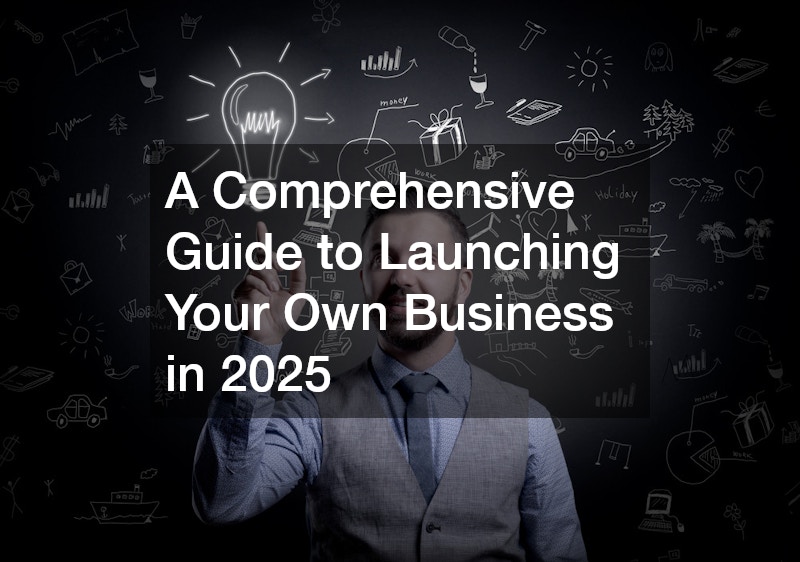Launching a new business in 2025 presents a unique mix of challenges and opportunities. Technology evolves rapidly, consumer expectations shift, and economic factors fluctuate. To navigate this landscape, aspiring entrepreneurs need a clear roadmap that covers everything from initial research to legal compliance and beyond. This guide offers a concise yet comprehensive overview of each stage, helping you make informed decisions and avoid common pitfalls.
By following a structured approach, you can minimize risks and position your venture for growth. Whether you’re just brainstorming ideas or ready to file paperwork, this guide will provide practical insights and actionable steps. From finding the right team to securing funding, you’ll learn how to transform your vision into a thriving enterprise.
Conducting Market Research
Before investing time or money, validate your business concept. Spending time on thorough research helps identify potential customers, competitors, and market gaps. Utilize surveys, focus groups, and industry reports to gather data. If you plan to acquire equipment or property, consider exploring 504 SBA loans to finance those big-ticket purchases through favorable terms. Probing the needs of your target demographic ensures you address actual demand rather than assumptions.
Next, analyze competitors in your niche to understand what differentiates you. Study their pricing, marketing tactics, and customer feedback. This intelligence can inform your own value proposition and help you identify underserved segments. Use online tools to track market trends and consumer sentiment, giving you a competitive edge when tailoring products or services.
Finally, synthesize your findings into a concise market research report. Summarize key insights into areas such as industry size, growth projections, and potential entry barriers. This report forms the foundation for your business plan, guiding decisions on product development, pricing, and positioning. With solid data, you’ll enter the planning stage confident rather than speculative.
Crafting a Solid Business Plan
A well-crafted business plan outlines your vision and strategies in a clear, organized manner. Begin with an executive summary that highlights your mission, target market, and financial projections. Investors and lenders often make initial judgments based solely on this section, so make every word count. In your plan’s facilities overview, research available commercial property to pinpoint locations that align with customer access and budget constraints.
Detail your products or services in the next section, explaining how you meet market needs. Highlight unique features that set you apart from competitors. For example, a local recycling company could emphasize eco-friendly processes that appeal to environmentally conscious consumers. By articulating your distinctive advantages clearly, you create compelling reasons for stakeholders to support your venture.
Finally, construct detailed financial projections, including revenue models, cost estimates, and break-even analysis. Outline planned expenses such as equipment, payroll, and marketing. Incorporate revenue forecasts over the first three to five years, reflecting optimistic yet realistic scenarios. Conclude with a discussion of business expansion strategies, demonstrating how you’ll scale operations once the initial launch proves successful.
Legal Structure and Compliance
Choosing the right legal structure is a critical decision with long-term implications. Common options include sole proprietorships, partnerships, limited liability companies (LLCs), and corporations. Each offers different liability protections, tax treatments, and administrative requirements. Consult with a seasoned business attorney to weigh the pros and cons and ensure compliance with state and federal regulations. Proper structuring now can save headaches and expenses later.
Once you settle on a legal form, address licensing and permits. Industry-specific regulations vary widely, so research requirements early. For example, if your business involves specialized contracts or agreements, engaging a contract lawyer can help draft watertight documents. This step ensures you follow intellectual property laws, zoning rules, and safety standards—avoiding costly penalties that arise from noncompliance.
After registration, establish internal policies covering hiring, payroll, and operations. Draft employee handbooks, nondisclosure agreements, and contractor arrangements. Ensure all documents adhere to employment laws and local ordinances. Ongoing compliance—such as filing annual reports and paying taxes—maintains good standing. Consistent attention to legal details safeguards your business’s reputation and viability over time.
Securing Financing

Capital acquisition is often one of the biggest hurdles for new entrepreneurs. Start by determining how much funding you need to cover startup costs like inventory, equipment, and initial payroll. Explore different financing options, including personal savings, friends and family investments, or venture capital. Many small businesses qualify for 504 SBA loans that offer low down payments and competitive interest rates. These loans can be particularly useful when purchasing fixed assets such as machinery or real estate.
Another route involves pursuing angel investors or crowdfunding campaigns. Angel investors typically seek equity in exchange for capital, while crowdfunding relies on broad public support. Each option has trade-offs: equity financing may dilute ownership, whereas crowdfunding requires extensive marketing efforts to succeed. Carefully weigh each path based on your industry and risk tolerance.
Finally, consider traditional bank loans or alternative lenders. Prepare a comprehensive loan package, including your business plan, financial projections, and credit history. A well-structured application increases your chances of approval. Compare interest rates, repayment schedules, and loan terms from multiple lenders. With funding secured, you can move forward confidently, investing in necessary resources without draining personal finances.
Choosing Your Location and Facilities
Selecting the right site sets the stage for operational efficiency and customer accessibility. First, analyze foot traffic patterns, proximity to target demographics, and local competition. High visibility often comes with higher costs, but can be instrumental for retail or service-based businesses. If your operations require manufacturing or warehousing, seek available commercial property that balances price and logistical advantages. Local economic development agencies often provide resources to help you identify suitable sites.
Once a location is identified, negotiate lease or purchase terms carefully. Factors such as lease duration, renewal options, and maintenance responsibilities can significantly impact long-term costs. Engage a real estate agent specializing in commercial transactions to guide you through negotiations. Ensure that zoning regulations align with your intended use and that the facility meets safety codes. If extensive renovations or tenant improvements are necessary, budget these expenses into your financial projections.
Finally, outfit your space with essential fixtures and signage. Investing in a high-quality custom business sign creates brand recognition and attracts foot traffic. Choose materials and designs that reflect your brand identity. Work with local contractors to install signage per municipal ordinances. A well-branded physical presence instills credibility in customers’ minds and fosters a professional atmosphere from day one.
Building Your Brand and Marketing
Developing a strong brand image is essential for differentiating yourself in a crowded market. Start by crafting a compelling brand story that resonates with your target audience. Your logo, color palette, and messaging should consistently communicate your core values and mission. Once established, create a marketing plan that outlines strategies for customer acquisition and retention. Utilize social media, search engine optimization, and content marketing to build awareness. Partnering with an experienced marketing agency can accelerate growth, but ensure their approach aligns with your vision.
Offline marketing efforts remain relevant in many industries. Distribute flyers, sponsor local events, and network within community organizations to generate word-of-mouth referrals. For businesses that rely on technology, offering reliable IT support service can be a selling point. Highlight how prompt technical assistance enhances customer satisfaction and prevents downtime. Feature this service prominently on your website and marketing materials to draw in clients who value uninterrupted operations.
Monitor marketing performance through key performance indicators such as website traffic, conversion rates, and customer acquisition costs. Adjust tactics based on real-time data, reallocating budgets to the most effective channels. Consistent review ensures your marketing efforts remain agile and responsive to market shifts. By combining digital and traditional methods, you’ll establish a robust presence that nurtures long-term customer relationships.
Setting Up Operations and Technology
Efficient operations underpin sustainable growth. Begin by mapping out workflows for production, service delivery, and administrative tasks. Standardize processes through documented procedures to minimize errors and training time. Implement a reliable point-of-sale system or project management software to track orders, inventory, and customer interactions. Investing early in scalable platforms prevents costly migrations as your business grows.
Next, secure reliable IT infrastructure tailored to your needs. Choose cloud-based solutions for data storage, email hosting, and collaboration tools to reduce upfront hardware costs. Outsourcing to a reputable IT support service ensures timely maintenance, cybersecurity updates, and tech troubleshooting. This partnership allows you to focus on core business functions, knowing your systems remain operational and secure.
Finally, coordinate logistics and supply chain management. If your business involves moving large equipment or inventory, partnering with reputable moving companies ensures timely deliveries without damage. Vet carriers based on reliability, insurance coverage, and cost. For businesses that handle physical goods, establish relationships with multiple vendors to mitigate supply disruptions. Well-orchestrated logistics streamline operations and enhance customer satisfaction from order placement to product fulfillment.
Hiring and Managing Your Team

Your team is the lifeblood of your business. Develop clear job descriptions outlining roles, responsibilities, and required qualifications. Create an attractive employment package with competitive salaries, benefits, and professional development opportunities. To legally onboard employees, collaborate with a knowledgeable recycling company only if you’re in the waste management sector; otherwise, focus on compliance with labor laws and tax regulations. Ensuring fair wages and safe working conditions fosters employee loyalty and minimizes turnover.
During recruitment, leverage multiple channels such as job boards, social media, and local networking events. Conduct thorough interviews, including skills assessments and cultural fit evaluations. Once hired, provide comprehensive orientation and training. Document policies in an employee handbook covering everything from workplace safety to code of conduct. Regular performance reviews help identify areas for improvement, set future goals, and reward high achievers.
Effective management hinges on open communication. Schedule weekly team meetings to discuss progress, challenges, and upcoming objectives. Encourage feedback and recognize achievements publicly, reinforcing a positive work environment. Address conflicts promptly with clear, respectful dialogue. By nurturing a collaborative culture, you empower employees to take ownership of their roles, driving innovation and productivity.
Launching and Initial Growth
The launch phase is when all planning becomes reality. Plan a grand opening event or promotional campaign to generate buzz. Utilize social media ads, email newsletters, and local press coverage to announce your arrival. Ensure your website is live with accurate information on products, services, and contact details. Test all systems—payment processing, inventory checks, and customer service lines—to ensure seamless operations from day one.
After launch, focus on gathering customer feedback to refine offerings. Distribute satisfaction surveys and monitor online reviews, responding promptly to both praise and criticism. Data-driven insights into customer behavior help you adjust pricing, marketing messages, and product features. As you gain traction, implement business expansion strategies to capture new market segments or launch complementary services. Small-scale pilots allow you to test these initiatives before committing significant resources.
Simultaneously, revisit financial metrics weekly to track cash flow and profitability. Monitor sales trends and adjust inventory levels to prevent overstock or shortages. If demand exceeds capacity, consider securing additional funding or partnerships to scale production. By balancing rapid response to customer needs with prudent financial management, you’ll sustain healthy growth and build a strong foundation for the future.
Planning for Long-Term Success

Long-term viability depends on strategic planning and continuous improvement. Conduct annual SWOT (Strengths, Weaknesses, Opportunities, Threats) analyses to evaluate your position in the market. Update your business plan with revised financial projections and growth targets. If you anticipate major capital expenditures—like acquiring new machinery—revisit options such as 504 SBA loans or private financing to fund expansion. Engaging a seasoned business attorney early helps ensure that expansion contracts and negotiations protect your interests.
Innovation drives longevity. Invest in research and development to stay ahead of industry trends. For service-based businesses, consider incorporating advanced technologies such as artificial intelligence or automation to enhance efficiency. If your operations handle physical assets, collaborate with a reputable recycling company to implement sustainable practices—an approach that resonates with eco-conscious consumers and can reduce operational costs. Emphasizing sustainability can also open doors to grants and incentives aimed at environmentally responsible companies.
Regularly review your marketing strategy to reach new audiences and retain loyal customers. Explore untapped channels—such as partnerships with local influencers or community organizations—that align with your brand values. Solicit feedback from your team and stakeholders to identify emerging opportunities or potential roadblocks. By embedding adaptability into your corporate culture, you ensure your business evolves alongside market dynamics, securing a prosperous future.
From hiring locksmith services to designing the signage, this process is multi-layered and comprehensive. Launching a business in 2025 requires meticulous planning, adaptability, and resourcefulness. From conducting market research to securing financing and assembling the right team, each step plays a critical role in your venture’s success. Legal compliance, solid branding, and streamlined operations form the backbone of a thriving company. By following the steps outlined in this guide, you’ll position your business to flourish in a competitive marketplace.
Remember that ongoing evaluation and strategic pivots are vital as market conditions change. Seek professional advice when necessary—whether from a contract lawyer for drafting agreements or a business attorney for complex legal matters. Focus on continuous improvement, embrace innovation, and cultivate a strong company culture. With dedication and a clear roadmap, you’ll not only launch your business successfully but also build a resilient enterprise capable of enduring future challenges.



